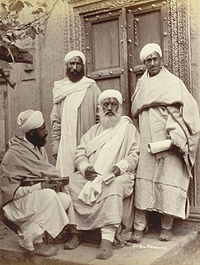
Back কাশ্মীরি পণ্ডিত Bengali/Bangla Kaŝmiraj Panditoj Esperanto Kashmiripanditit Finnish कश्मीरी पंडित Hindi ಕಾಶ್ಮೀರಿ ಪಂಡಿತರು Kannada کٲشِرؠ پنٛڈِت Kashmiri കശ്മീരി പണ്ഡിറ്റ് Malayalam काश्मिरी पंडित Marathi Kasjmiri pandit Dutch ਕਸ਼ਮੀਰੀ ਪੰਡਤ Punjabi
 Kashmiri Pandits in Srinagar, c. 1895 CE | |
| Total population | |
|---|---|
| 300,000[1][2][3] to 600,000[4][5][6] (est. living in the Kashmir Valley prior to 1990) | |
| Regions with significant populations | |
| Historically: Kashmir Other communities: Jammu, National Capital Region • Ladakh • Uttar Pradesh • Himachal Pradesh • Uttarakhand • Haryana • Rajasthan • Indian Punjab | |
| Languages | |
| Sacred languages Sanskrit Ethnic language Hindi, Dogri, English | |
| Religion | |
| Related ethnic groups | |
| Kashmiris (Kashmiri Hindus, Kashmiri Muslims), Saraswat Brahmins |
The Kashmiri Pandits (also known as Kashmiri Brahmins)[7] are a group of Kashmiri Hindus and a part of the larger Saraswat Brahmin community of India. They belong to the Pancha Gauda Brahmin group[8] from the Kashmir Valley,[9][10] located within the Indian union territory of Jammu and Kashmir. Kashmiri Pandits are Hindu Kashmiris native to the Kashmir Valley, and the only remaining Hindu Kashmiris after the large-scale of conversion of the Valley's population to Islam during the medieval times.[11][12] Prompted by the growth of Islamic militancy in the valley, large numbers left in the exodus of the 1990s. Even so, small numbers remain.
- ^ Singh, Devinder (21 November 2014). "Reinventing Agency, Sacred Geography and Community Formation: The Case of Displaced Kashmiri Pandits in India". The Changing World Religion Map. Dordrecht: Springer Netherlands. pp. 397–414. doi:10.1007/978-94-017-9376-6_20. ISBN 9789401793759.
- ^ "Protection Aspects of Unhcr Activities on Behalf of Internally Displaced Persons". Refugee Survey Quarterly. 14 (1–2): 176–191. 1995. doi:10.1093/rsq/14.1-2.176. ISSN 1020-4067.:The mass exodus began on 1 March 1990, when about 250,000 of the 300,000 Kashmiri Pandits fled the State
- ^ Yong, Amos (2011). "Constructing China's Jerusalem: Christians, Power, and Place in Contemporary Wenzhou - By Nanlai Cao". Religious Studies Review. 37 (3): 236. doi:10.1111/j.1748-0922.2011.01544_1.x. ISSN 0319-485X.
- ^ Casimir, Michael J.; Lancaster, William; Rao, Aparna (1 June 1997). "Editorial". Nomadic Peoples. 1 (1): 3–4. doi:10.3167/082279497782384668. ISSN 0822-7942.:From 1947 on, Kashmir's roughly 700,000 Hindus felt increasingly uneasy and discriminated against, and youth ... from a variety of sources such as Islamist organizations, Islamic countries, Kashmiri Muslim fund raisers in the West, and migrant labor from Azad Kashmir in the ...
- ^ Sarkaria, Mallika Kaur (2009). "Powerful Pawns of the Kashmir Conflict: Kashmiri Pandit Migrants". Asian and Pacific Migration Journal. 18 (2): 197–230. doi:10.1177/011719680901800202. ISSN 0117-1968. S2CID 145137184.:... of the Centre of Central Asian Studies, Kashmir University, and member of Panun Kashmir (a Pandit ... the Valley in 1990, believes "it could be anything between 300,000 to 600,000 people
- ^ PTI. "30 years on, return to homeland eludes Kashmiri Pandits". Retrieved 19 April 2019.
- ^ Duchinsky, Haley (26 September 2013). "Survival is now our Politics: Kashmiri Hindu community identity and the Politics of Homeland". International Journal of Hindu Studies. 12 (1). academia.edu: 41–64.
- ^ Brower, Barbara; Johnston, Barbara Rose (2016). Disappearing Peoples?: Indigenous Groups and Ethnic Minorities in South and Central Asia. Routledge. ISBN 9781315430393.
Kashmiri Hindus are all Saraswat brahmins, known by the exonym Pandit (the endonym being Batta), a term first reserved for emigrant Kashmiri brahmins in Mughal service.
- ^ Lyon, Peter (2008). Conflict between India & Pakistan: An Encyclopedia. Bloomsbury Academic. p. 99. ISBN 9781576077122.
- ^ Essa, Assad (2 August 2011). "Kashmiri Pandits: Why we never fled Kashmir". aljazeera.com.
- ^ Kaw, M. K. (2004). Kashmir and Its People: Studies in the Evolution of Kashmiri Society. APH. p. 183. ISBN 9788176485371.
- ^ Siddhartha Gigoo, Varad Sharma (18 October 2016). A Long Dream of Home: The persecution, exile and exodus of Kashmiri Pandits. Bloomsbury Publishing. ISBN 9789386250254.